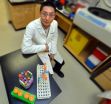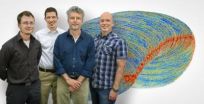(Press-News.org) Once rhesus monkeys learn to associate a picture with a reward, the reward by itself becomes enough to alter the activity in the monkeys' visual cortex. This finding was made by neurophysiologists Wim Vanduffel and John Arsenault (KU Leuven and Harvard Medical School) and American colleagues using functional brain scans and was published recently in the leading journal Neuron.
Our visual perception is not determined solely by retinal activity. Other factors also influence the processing of visual signals in the brain. "Selective attention is one such factor," says Professor Wim Vanduffel. "The more attention you pay to a stimulus, the better your visual perception is and the more effective your visual cortex is at processing that stimulus. Another factor is the reward value of a stimulus: when a visual signal becomes associated with a reward, it affects our processing of that visual signal. In this study, we wanted to investigate how a reward influences activity in the visual cortex."
To do this, the researchers used a variant of Pavlov's well-known conditioning experiment: "Think of Pavlov giving a dog a treat after ringing a bell. The bell is the stimulus and the food is the reward. Eventually the dogs learned to associate the bell with the food and salivated at the sound of the bell alone. Essentially, Pavlov removed the reward but kept the stimulus. In this study, we removed the stimulus but kept the reward."
In the study, the rhesus monkeys first encountered images projected on a screen followed by a juice reward (classical conditioning). Later, the monkeys received juice rewards while viewing a blank screen. fMRI brain scans taken during this experiment showed that the visual cortex of the monkeys was activated by being rewarded in the absence of any image.
Importantly, these activations were not spread throughout the whole visual system but were instead confined to the specific brain regions responsible for processing the exact stimulus used earlier during conditioning. This result shows that information about rewards is being sent to the visual cortex to indicate which stimuli have been associated with rewards.
Equally surprising, these reward-only trials were found to strengthen the cue-reward associations. This is more or less the equivalent to giving Pavlov's dog an extra treat after a conditioning session and noticing the next day that he salivates twice as much as before. More generally, this result suggests that rewards can be associated with stimuli over longer time scales than previously thought.
Why does the visual cortex react selectively in the absence of a visual stimulus on the retina? One potential explanation is dopamine. "Dopamine is a signalling chemical (neurotransmitter) in nerve cells and plays an important role in processing rewards, motivation, and motor functions. Dopamine's role in reward signalling is the reason some Parkinson's patients fall into gambling addiction after taking dopamine-increasing drugs. Aware of dopamine's role in reward, we re-ran our experiments after giving the monkeys a small dose of a drug that blocks dopamine signalling. We found that the activations in the visual cortex were reduced by the dopamine blocker. What's likely happening here is that a reward signal is being sent to the visual cortex via dopamine," says Professor Vanduffel.
The study used fMRI (functional Magnetic Resonance Imaging) scans to visualise brain activity. fMRI scans map functional activity in the brain by detecting changes in blood flow. The oxygen content and the amount of blood in a given brain area vary according to the brain activity associated with a given task. In this way, task-specific activity can be tracked.
###
The full text of the study "Dopaminergic reward signals selectively decrease fMRI activity in primate visual cortex" is available on the Neuron website: http://www.cell.com/neuron/abstract/S0896-6273(13)00052-4?utm_source=ECE001&utm_campaign=&utm_content=&utm_medium=email&bid=BKXPH4F:90EZ4
Reward linked to image is enough to activate brain's visual cortex
2013-03-21
ELSE PRESS RELEASES FROM THIS DATE:
Do disruptions in brain communication have a role in autism?
2013-03-21
New Rochelle, NY, March 21, 2013—A new study of patterns of brain communication in toddlers with autism shows evidence of aberrant neural communication even at this relatively early stage of brain development. The results are presented in an article in Brain Connectivity, a bimonthly peer-reviewed journal from Mary Ann Liebert, Inc., publishers. The article is available free on the Brain Connectivity website at http://www.liebertpub.com/brain.
A team of researchers from The Netherlands (University Medical Center Utrecht and Utrecht University, Radboud University Nijmegen ...
Cancer drug shortages mean higher costs and greater risk for patients
2013-03-21
A national survey of health professionals showed that drug shortages are taking a heavy toll on cancer patients, forcing treatment changes and delays that for some patients meant worse outcomes, more therapy-related complications and higher costs. St. Jude Children's Research Hospital investigators played an important role in the study.
The survey queried oncology pharmacists and others involved in managing cancer drug shortages for academic medical centers, community hospitals and other cancer treatment facilities nationwide. Of the 243 individuals who completed the ...
Scientists identify gene that is consistently altered in obese individuals
2013-03-21
AUGUSTA, Ga. – Food and environment can chemically alter your gene function and scientists have identified a gene that is consistently altered in obesity.
The gene LY86 was among a group of 100 genes identified as likely contributors to obesity through genome-wide association studies comparing the DNA of thousands of obese and lean individuals, said Dr. Shaoyong Su, genetic epidemiologist at the Medical College of Georgia at Georgia Regents University.
Su looked at progressively larger groups of obese versus lean individuals and found LY86 consistently and highly chemically ...
Researchers' new method may sharpen microscopic images
2013-03-21
UT Dallas researchers are developing a new low-light imaging method that could improve a number of scientific applications, including the microscopic imaging of single molecules in cancer research.
Electrical engineering professor Dr. Raimund Ober and his team recently published their findings in the journal Nature Methods. In the journal, they describe a method which minimizes the deterioration of images that can occur with conventional imaging approaches.
"Any image you take of an object is translated by the camera into pixels with added electronic noise," Ober said. ...
Do I know you? Memory patterns help us recall the social webs we weave, finds new Cornell study
2013-03-21
ITHACA, N.Y. — With a dizzying number of ties in our social networks – that your Aunt Alice is a neighbor of Muhammad who is married to Natasha who is your wife's boss – it's a wonder we remember any of it. How do we keep track of the complexity? We cheat, says a Cornell University sociologist in Scientific Reports (March 21), a publication of Nature.
Study: http://www.nature.com/srep/2013/130321/srep01513/full/srep01513.html
Humans keep track of social information not by rote memorization but with simplifying rules, as you might remember a number sequence that always ...
Genetic risk strategies needed for young, black, female breast cancer patients, Moffitt study shows
2013-03-21
Researchers at Moffitt Cancer Center and colleagues in Canada have published study results focused on black women younger than 50, a population disproportionately afflicted with and dying from early-onset breast cancer compared to their white counterparts. The research published in the Jan. 16 issue of The Breast Journal.
Early-onset breast cancer has been associated with mutations in the BRCA1 and BRCA2 genes. These breast cancer predisposing genes were discovered almost 20 years ago and confer a lifetime risk of breast cancer of 60 to 70 percent, as well as a much higher ...
Berkeley Lab scientists read the cosmic writing on the wall
2013-03-21
Thanks to a supersensitive space telescope and some sophisticated supercomputing, scientists from the international Planck collaboration have made the closest reading yet of the most ancient story in our universe: the cosmic microwave background (CMB).
Today, the team released preliminary results based on the Planck observatory's first 15 months of data. Using supercomputers at the U.S. Department of Energy's (DOE) National Energy Research Scientific Computing Center (NERSC) Planck scientists have created the most detailed and accurate maps yet of the relic radiation ...
For the first time, recommendations offer guidance about incidental genetic findings
2013-03-21
Boston – In a highly anticipated report, landmark recommendations on the handling of incidental findings in clinical genome and exome sequencing are being issued from the American College of Medical Genetics and Genomics (ACMG). A report of the recommendations, led by Robert C. Green, MD, MPH, a medical geneticist at Brigham and Women's Hospital (BWH), outlines for the first time a minimum list of genetic conditions, genes and variants that laboratories performing clinical sequencing should seek and report to the physicians that ordered the testing -- regardless of the ...
European Guidance for the diagnosis & management of osteoporosis in postmenopausal women
2013-03-21
A new Guidance recently published by the European Society for Clinical and Economic Aspects of Osteoporosis (ESCEO) and the International Osteoporosis Foundation (IOF) reflects the most current advances in the diagnosis and management of osteoporosis, the 'silent disease' which affects up to one in two postmenopausal women.
"The serious impact of fragility fractures due to osteoporosis is vastly underestimated by many health care professionals," stated ESCEO President Professor Jean-Yves Reginster.
"Statistics clearly show that fragility fractures in older adults ...
Differences in bone healing in old mice may hold answers to better bone healing for seniors
2013-03-21
Philadelphia – By studying the underlying differences in gene expression during healing after a bone break in young versus aged mice, Jaimo Ahn, MD, PhD, assistant professor of Orthopaedic Surgery at the Perelman School of Medicine, University of Pennsylvania, and his colleagues aim to find specific pathways of fracture healing in humans. The team of researchers will present their findings in a poster presentation beginning Tuesday, March 19, 2013 at the 2013 American Academy of Orthopedic Surgeons annual meeting in Chicago.
Problems with healing after bone fractures ...


